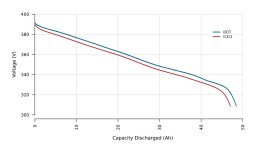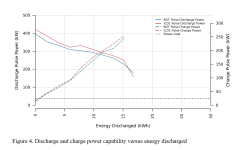Just acquired six Chevy Malibu modules, unbelievably low mileage....< 25,000 miles.....each module is 8x5x5 inch and is eight lbs they are 36 volt made up of ten Hitachi prismatic foil cells, and have pos/neg posts....any additional info anyone could add would be useful, I'll in turn post any updates as I investigate further......thx
You are using an out of date browser. It may not display this or other websites correctly.
You should upgrade or use an alternative browser.
You should upgrade or use an alternative browser.
Salvaged EV cells index: Leaf, Volt, Tesla, Zero, etc
- Thread starter spinningmagnets
- Start date
From landrover Discovery SPORT iEWD 2021.
7 x 48V modules each 12S1P Samsung SDI. Connected in series. for a 400V system.

I want to use them for an off grid solar storage system.
There appears to be a BMS per module. But I don't know if these work without the central control sytem.
Now testing if they want to balance without being connected to the central system.
I have tried to find documentation using the Samsung model numbers on the battery modules, but so far no luck.
If anyone has anything let me know.
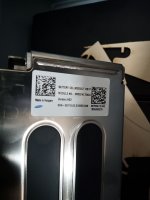
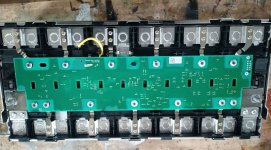

7 x 48V modules each 12S1P Samsung SDI. Connected in series. for a 400V system.

I want to use them for an off grid solar storage system.
There appears to be a BMS per module. But I don't know if these work without the central control sytem.
Now testing if they want to balance without being connected to the central system.
I have tried to find documentation using the Samsung model numbers on the battery modules, but so far no luck.
If anyone has anything let me know.



Can you get pics of the component side of the PCB? Then we can see if there even are any balancers on it (it may only be monitoring--if the cells are good and well-matched and used like most EVs use them, then by the time they start becoming unbalanced they'll probably need replacement anyway for capacity/etc reasons, in the OEM EV usage)
electric_nz
1 kW
- Joined
- Jan 7, 2019
- Messages
- 308
I have an offer of Mitsubishi PHEV cells- yuasa LEV46 in 8s1p modules, each weighing 13kg.
But from what I can see each cell is 46AH for 1.5kg which is about half the energy density of a common 21700 cell.
For an application like an e-bike where space and weight are important these seem like a poor choice?
But from what I can see each cell is 46AH for 1.5kg which is about half the energy density of a common 21700 cell.
For an application like an e-bike where space and weight are important these seem like a poor choice?
Hillhater
100 TW
Yes,..they are a poor choice for an ebike !For an application like an e-bike where space and weight are important these seem like a poor choice?
Depends on your needs.
If you need large capacity, high current capability (500A burst, 200A sustained discharge *and charge* for 1p) with little voltage sag (1mohm cell resistance), and a pack that will probably not need balancing very often, if ever (because EV grade cells all in the same modules are very likely to be very well matched in characteristics and stay that way for a long time), and have plenty of room and no specific shape/volume constraints, then they'll be a great match.
Large cargo bikes, trikes, etc like my SB Cruiser can use this kind of pack (I have some ancient >decade-old EIG cells on it now that will need to be replaced someday, and these sound like a contender).
Motorcycles and scooters could, too, if they don't need a lot of capacity but do need power.
A disadvantage is that you need to leave them in the module mechanical constraint housings, to keep the pressure on the cells, or build your own constraint housing, so they don't expand (cylindrical cells don't have this issue, because of their casing shape)..
See the LEV46 specs in teh chart below, copied from
https://www.lithiumenergy.jp/en/products/#product_introduction
��
GS Yuasa Delivers Wind Power Storage System to Hagigaoka Water Treatment Plant in Wakkanai City, Hokkaido Contributing to achievement of carbon neutrality targets through power storage devices
If you need large capacity, high current capability (500A burst, 200A sustained discharge *and charge* for 1p) with little voltage sag (1mohm cell resistance), and a pack that will probably not need balancing very often, if ever (because EV grade cells all in the same modules are very likely to be very well matched in characteristics and stay that way for a long time), and have plenty of room and no specific shape/volume constraints, then they'll be a great match.
Large cargo bikes, trikes, etc like my SB Cruiser can use this kind of pack (I have some ancient >decade-old EIG cells on it now that will need to be replaced someday, and these sound like a contender).
Motorcycles and scooters could, too, if they don't need a lot of capacity but do need power.
A disadvantage is that you need to leave them in the module mechanical constraint housings, to keep the pressure on the cells, or build your own constraint housing, so they don't expand (cylindrical cells don't have this issue, because of their casing shape)..
See the LEV46 specs in teh chart below, copied from
https://www.lithiumenergy.jp/en/products/#product_introduction
| LEV40 | LEV46 | LEV50 | LEV61 (Under Development) | LEV65 (Under Development) | LEV60F | LEPS-1 | LEPS-2 | ||
|---|---|---|---|---|---|---|---|---|---|
| Cell | |||||||||
| Application | PHEV | PHEV | EV | EV | PHEV | 12V | ESS | ESS | |
| Cell Form | Prismatic | Prismatic | Prismatic | Prismatic | Prismatic | Prismatic | Prismatic | Prismatic | |
| Typical Capacity | 40 Ah | 46 Ah | 50 Ah | 61 Ah | 64 Ah | 74 Ah | 65 Ah | 75 Ah | |
| Weight | 1.40 kg | 1.49 kg | 1.65 kg | 1.72 kg | 1.37 kg | 2.17 kg | 1.47 kg | 1.71 kg | |
| Size | W | 171mm | 171mm | 171mm | 171mm | 171mm | 171mm | 171mm | 171mm |
| T | 34mm | 34mm | 44mm | 44mm | 34mm | 55mm | 34mm | 44mm | |
| H※ | 108mm | 108mm | 98mm | 98mm | 103mm | 115mm | 108mm | 98mm | |
| Voltage | Nominal Voltage | 3.75V | 3.75V | 3.75V | 3.75V | 3.70V | 3.2V | 3.71V | 3.71V |
| Voltage Range | 2.75 - 4.1 V | 2.75 - 4.1 V | 2.75 - 4.1 V | 2.75 - 4.2 V | 2.75 - 4.25 V | 2.0 - 3.5 V | 2.75 - 4.25 V | 2.75 - 4.25 V | |
| Power (Maximum Current) | 25℃、SOC50%、10sec. | 1,700 W (500 A) | 1,680 W (500 A) | 1,110 W (300 A) | 1,355 W (500 A) | 1,655 W (515 A) | 1,780 W (600 A) | 450 W (126 A) | 526 W (146 A) |
| Resistance | 25℃、SOC50%、10sec. | 1.0 mΩ | 1.0 mΩ | max. 1.0 mΩ | 0.9 mΩ (Maximum) | 0.9 mΩ (Maximum) | 0.7 mΩ | 1.0 mΩ | 0.8 mΩ |
| Maximum Charge / Discharge Current (continuous at 25℃) | 200A/200A | 200A/200A | 125A/200A | 228.75A*/200A *limited depending on voltage | 352A*/200A *limited depending on voltage | 180A/180A | 63A/63A | 73A/73A |
GS Yuasa Delivers Wind Power Storage System to Hagigaoka Water Treatment Plant in Wakkanai City, Hokkaido Contributing to achievement of carbon neutrality targets through power storage devices
Have you found similar information for Hybrid Vehicles, this was really helpful, but I need similar information for Hybrid Vehicles, I am not able to correctly identify cell weight. how did you collect this information.?Looks like your link is dead now too, but I saved it since it's an excellent reference. Attached to my post here also.
DogDipstick
100 kW
Here is the link to the original author of the spreadsheet.Have you found similar information for Hybrid Vehicles, this was really helpful, but I need similar information for Hybrid Vehicles, I am not able to correctly identify cell weight. how did you collect this information.?
You might find good info t here. there are many many EV forum spreadsheets available nowadays if you look. People love making them. Many more today rather the ones I found all those years ago.
thank the Chris guy for this one. There are tons nowadays if you just google
EV battery spreadsheet" anymore.. but the guy was the original one that I linked. Here it is.
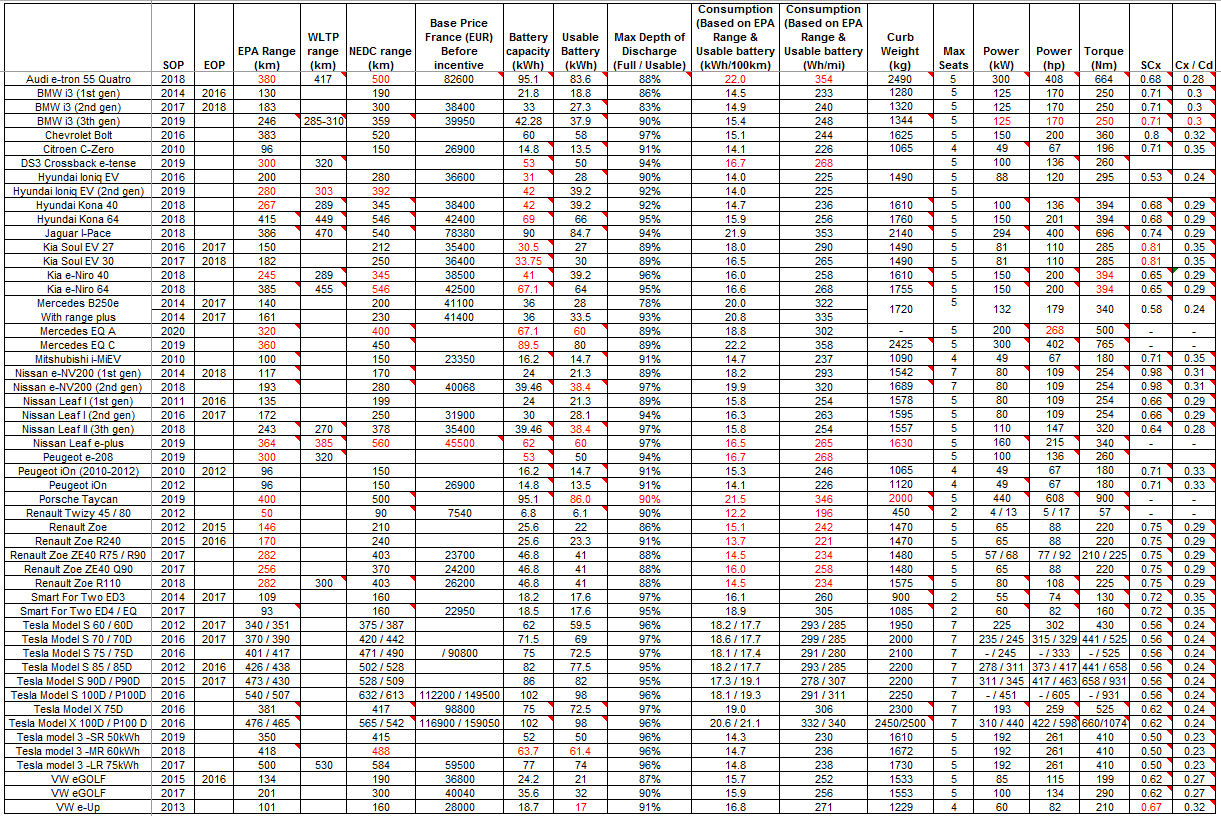
Comparative EV and Battery pack specs
Hello, Since several month i have initiated a comparative on EV specs including the battery pack specs. The estimation are written on red. I added also the sources by adding a comment on the cell. The excel file is available on the file EV_Specs 12.01.2019.zip Let me know if you see any...
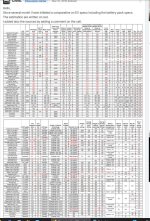
DogDipstick
100 kW
Another one: Thousands of EV cells indexed.
Example: 400kW from a Chevrolet Volt pack 2016+ Peak
So by nw I ahe built about eight large packs for friends and customers. All still live. Most recently? I have a friend I turned onto a 25aH Chevrolet cell. He built a 9.6kWh Volt cell pack, 26s, 4p, 100aH... 100lbs approx... and fit it on a Ducati Monster. I am looking forward to his results.
Check this out.
ADVANCED EV CELL TESTING RESULTS
Example: 400kW from a Chevrolet Volt pack 2016+ Peak
So by nw I ahe built about eight large packs for friends and customers. All still live. Most recently? I have a friend I turned onto a 25aH Chevrolet cell. He built a 9.6kWh Volt cell pack, 26s, 4p, 100aH... 100lbs approx... and fit it on a Ducati Monster. I am looking forward to his results.
Check this out.
ADVANCED EV CELL TESTING RESULTS
Attachments
Porsche and VW, they seemed to have collaborated on several design features of the modules. VW uses a roughly 400V architecture, and Porsche uses 800V. The modules look identical, except the VW cells are twice as long, with the end-caps being identical.
For configuring a DIY pack for a motorcycle, I would initially design a pack out of the smaller Porsche cells, and then compare that to other options. Both are flat pouch cells, and for providing high amps, the cells are mated 2P inside the module, but teardowns show they can be easily separated into individual cells.
Each module is 6S/2P, but contain 12 cells.
Porsche Taycan cells
VW ID3/ID4 pack teardown
For configuring a DIY pack for a motorcycle, I would initially design a pack out of the smaller Porsche cells, and then compare that to other options. Both are flat pouch cells, and for providing high amps, the cells are mated 2P inside the module, but teardowns show they can be easily separated into individual cells.
Each module is 6S/2P, but contain 12 cells.
Porsche Taycan cells
VW ID3/ID4 pack teardown
Ford Lightning Truck,
Ford Mustang Mach-E
Another teardown video from Munro Live on youtube. In this pic they are showing the difference between the Ford Lightning truck cell and the Ford Mustang Mach-E cell. They are both the same thickness, but the truck cell is slightly taller and wider.
The Lightning module has roughly 40 cells.

Ford Mustang Mach-E
Another teardown video from Munro Live on youtube. In this pic they are showing the difference between the Ford Lightning truck cell and the Ford Mustang Mach-E cell. They are both the same thickness, but the truck cell is slightly taller and wider.
The Lightning module has roughly 40 cells.

Similar threads
- Replies
- 17
- Views
- 6,545
- Replies
- 10
- Views
- 2,940
- Replies
- 26
- Views
- 9,021
- Replies
- 2
- Views
- 760


